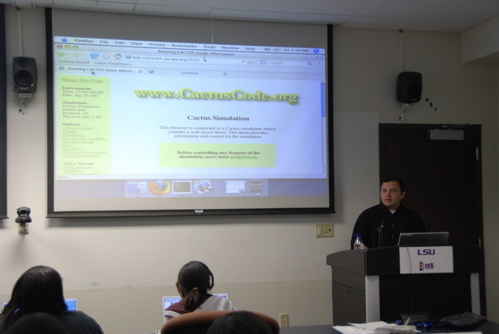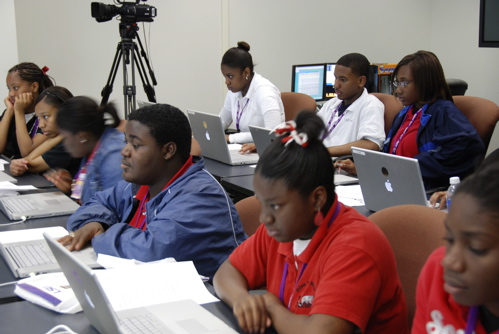One day workshop organized by CCT and the NSF IGERT program
On April 20, 2007, the LSU IGERT students and CCT organized a workshop for 32 Baton Rouge high school students and their teachers.
During the one day workshop that started with presentations by Dr. Ed Seidel and Dr. Joel Tohline, and ended with a wrap-up talk by Dr. Gabrielle Allen, the K-12 students took part in two tutorials. Yaakoub El-Khamra taught them how to compile and run Cactus in parallel on the LONI supercomputers to simulate the head on collision of black holes, while the IGERT students showed them how to do scientific visualization using Amira.
Baton Rouge – LSU researchers with the National Science Foundation’s Integrative Graduate Education and Research Traineeship, or IGERT, program and the Center for Computation & Technology, or CCT, hosted a workshop Friday, April 20, for more than 30 high school students and their teachers.
The IGERT on Computational Fluid Dynamics at LSU is a National Science Foundation program that provides doctoral students with an enhanced, multidisciplinary education and training to prepare them for research in multiscale computational fluid dynamics and its application to complex problems in science and engineering.
CCT Director Ed Seidel began the workshop by talking to the students about research projects taking place at the center, and showed how today’s computing resources and technology help young science students gain a better understanding about complex topics than was previously available. Seidel also gave the students a brief presentation on his work in numerical relativity, which involves studying black hole collisions to model gravitational waves. He showed the students several visualizations of what it looks like when two black holes collide.
CCT and LSU physics Professor Joel Tohline also gave the students a presentation on what computational fluid dynamics is and how it is studied at the CCT. Tohline explained that this means studying fluid flows in nature, which is a significant part of the research in his “Coast to Cosmos” focus area at CCT.
“To do sophisticated modeling of fluid flow in nature, we need interdisciplinary research and computational resources,” Tohline explained. He showed varying examples of fluid flow that scientists can study, ranging from hurricane modeling to flight for birds or airplanes.
One of the main developers of Cactus was CCT researcher Gabrielle Allen, Ph.D. Cactus has been used for more than 100 research publications in the field of numerical relativity alone, and is now being extended partly though the IGERT program to be used for fluid dynamics applications.



